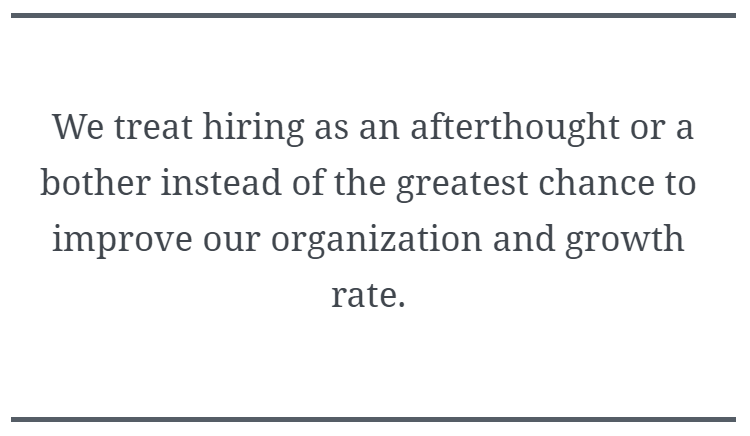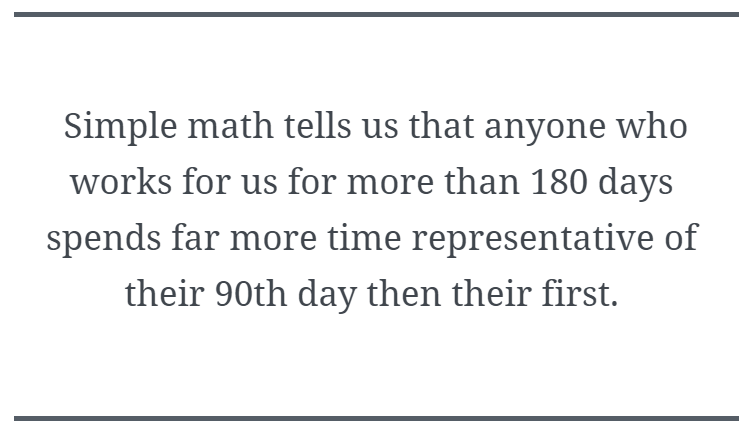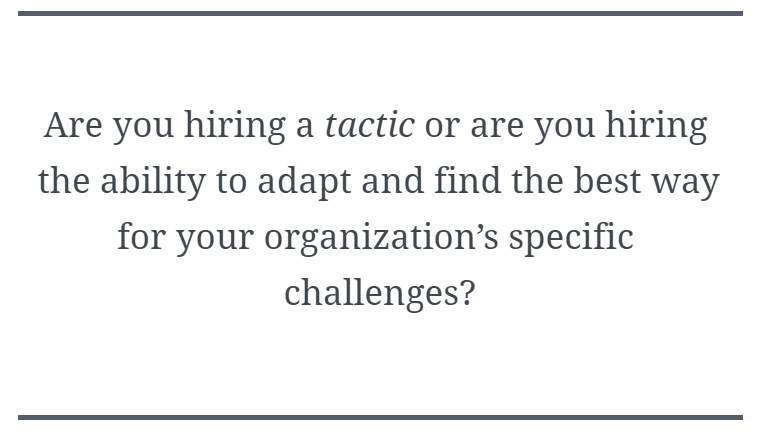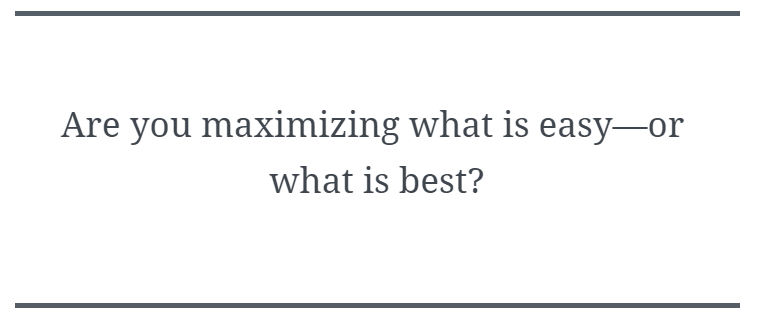No hiring process in the world is designed to hire the best and brightest.
- Are you talking to everyone in the world that does that job? That could do that job?
- Are you able to measure directly the marginal value two years from now of hiring Person A versus Person B?
- Are you hiring based on efficiency of time and resources?
- Are you hiring based on total impact to the organization—or just what a potential hire will do with specific tasks?
- How about the fit to the entire organization, not just to the role?
No, you’re talking to who is available, without the ability to measure or know their impact, with only a smile, a suit, a piece of paper, and a few minutes of conversation to figure out things that have a massive long-term impact on your business.
Getting and managing the right people in your organization is vital to all forms of future success. So many organizations say they are who they are because of the people they have and how they hire. They say that their specific process has led to their success, and they would never change it.
The truth is that, while you may have a “process” and current people, you’ve done little to maximize the effectiveness of the process. Would you have been 10X your size or growth rate with different people? Would you be worse off? Most have stories but little else to stand by.
A growth mindset has to be part of every person you bring in. It has to be at the core of how teams are built and how success is measured. We can’t directly measure specific traits. But we can maximize the probability of success. To do that, however, we have to rethink the entire process.
Table of contents
How we hire now—and why it doesn’t work
How many of the questions above can you directly, correctly measure in your hiring process? The answer for almost all groups is a resounding zero.
Some groups get parts right, yet none really connects the process and filters with the desired outcomes. Most groups just follow a set process because it’s what they’ve seen or what someone else told them to do.
We have a process that demands people tell you what you want to hear and make themselves more charming, not more valuable. We treat hiring as an afterthought or a bother instead of the greatest chance to improve our organization and growth rate.

What does hiring the best really mean? How are companies comparing their options? Are they relying on data or just “feel”? Are they confusing a potential hire’s impact on the business with the Halo effect of one specific trait?
What do you really get if you hire Person A vs. Person B? Is it a 10% difference? A 20% difference? How can you tell? Remember that all their experience simply lays the groundwork for Day 1—it doesn’t guarantee that they’ll be able to identify and tackle the problems for your organization, your use case.
For most people, hiring is nothing more than deciding who they want to date, not romantically but in a sense that they check off basic traits and then decide how much they like that person.

The question, “Do I want to have drinks with this person?” trumps the actual impact and value to the organization in almost every case, resulting in teams picking the best person of the first group they talk to, or, even worse, waiting forever to find the perfect “fit”—even if that’s an undefinable or unmeasurable quality.
Let that sink in. So many groups talk about finding the right people or how selective they are, but so few even understand what they’re doing.
So what makes for a successful hire?
Step one is defining “growth,” not some arbitrary growth “team.” You can never know if you’re successful if you don’t know what you’re trying to achieve.
Growth can be defined as “maximizing the resources and time of every action to create the most positive impact to the bottom line of the business.” In other words, just being able to do something isn’t good enough.
Can they improve what they’re doing? Can they find new opportunities? Can they try new things and consistently improve? Complacency is the death of value, so can they always question and find new ways to make the business work better?

This isn’t some greedy “only business matters” view. This is about the fact that more success for the business means more success for the people in the business—more hires, more new opportunities, more projects, and more impact.
It’s about maximizing the net impact from everyone and not just the localized personal impact (as in some distorted version of the Prisoner’s Dilemma). Under that agreed-on view of what we’re trying to accomplish, let’s see what does and doesn’t matter in terms of hiring.
Does experience matter?
Not as much as you think. Time in a position is not the same as time improving. Time in one industry also means a limit on other ways of tackling problems and assumes that two companies in the same industry need to act the same way.
Specific tactics learned most likely won’t work, but if a potential hire can understand problems and discover solutions, then they have a better chance of being successful.
We want to maximize future value, so the wider their experience, the more they have been wrong or learned, the more they have challenged commonly held beliefs, and how and why they hold themselves accountable are what increase the chance of future success.
Most importantly, do they know how to scope and prioritize work correctly, or do they repeat the work from a previous job like some robotic parrot?
What about technical skills, like coding languages and portfolios?
Well, how long does it take to learn the differences between one language and another, as opposed to learning and building core systems and solving core problems?
Does a visually impressive portfolio translate to high-impact design? How many designers even understand the marginal gain of each design they’ve created?
Let’s instead look at the multitude of ways in which they can solve a problem. Can they get past what people want or what they think is best and instead pivot to what works best? How interested are they in the total impact? How tied are they to their stories and their portfolio?
These are the questions we need to ask.
How about more qualitative things like positivity and communication?
Well, let’s ignore the fact that all interviews are dog-and-pony shows for which people are on their best behavior, not unlike a first date. You’re seeing the absolute best of them. (Let’s also ignore the fact that positivity ties directly to awful decision-making.)
Let’s instead consider that no part of the process will show you what they send on the 10th hour worked on a Thursday night when under stress and managing five competing priorities. That’s when communication breaks down—not when everyone is on their best behavior with no skin in the game.
Instead, let’s ask if they’ll tell people what they need to hear and not what they want to hear. Do they stand up and disagree when everyone else in the room is just nodding their head? Can they talk to each group on their level? Does what they say add value or just make you feel good?
What about specific skills to the job—doing X analysis, using Y tool, familiarity with Z marketplace?
You don’t know where a new hire will be a few months in—what the marginal gain is not on Day 1 but Day 90. Simple math tells us that anyone who works for us for more than 180 days spends far more time representative of their 90th day then their first.

With that in mind, let’s look at a few random requirement sections from jobs posted on LinkedIn. I’ve bolded items that tie to things that (1) actually maximize the chance of success and (2) bring the right mindset into your organization.
- 5+ years of Product Design experience (special consideration given to those with expert knowledge on the design of highly converting landing pages)
- Being fun to work with, open-minded, collaborative and creative
- Amazing portfolio, showing examples of cloud-based SaaS interfaces
- Equally strong in UX and UI, able to share detailed examples of your work
- Ability to take ownership over the entire lifecycle of a design project from research, wireframing, and rapid prototyping, to the delivery of final high-fidelity assets
- Experience working with a design system
- Commitment to a fast, self-driven, iterative approach to design
- Ability to spot issues with information architecture and hierarchy
- Experience conducting usability testing to gather feedback
- Ability to work cross-functionally
- Ability to communicate effectively
Or another:
- Strong Work Ethic
- Optimistic Problem Solver
- Team Player – willing to roll-up the sleeves and be a utility infielder as required
- Accountable & Dependable – consistently “Does What They Say They’re Going To Do”
- Resourceful – consistently gets the important things done with limited direction
- Self-motivated
- Strong Attention to Detail
- Trustworthy & Honest
- High Sense of Urgency
- Well Organized
- Quick Learner
- Seeks Team and Company Success Over Self-Promotion
Or yet another:
- Comfort working as a “full-stack” growth analyst to scope projects: ability to write and functionalize code, design and run tests, surface and visualize results, monitor outcomes, and present succinct strategies as a result of analyses
- High proficiency in SQL and working knowledge in at least one scripting/statistical language (R, Python preferred)
- Logical and structured thinking to handle ambiguous questions with ease
- Ability to communicate findings clearly to both technical and non-technical audiences
- 1+ years of experience in analytically-driven roles (analytics, consulting, finance, etc.)
- Developer experience in Looker is a strong plus
Of the 29 bullet points listed, only 3 are (sort of) aligned with outcomes. Only one—even though unmeasurable—is fully aligned. If only ~10% of what you say you’re looking for has any tie to outcomes, why are you even hiring the position?
How to hire for growth
Instead of trying to fix a broken system, let’s reinvent it. First, consider the traits we want to learn about:
- Will this person be able to grow in the job?
- Will this person find new and different ways to tackle problems?
- Does this person bring something new to the organization?
- Will this person speak up and challenge the organization when things are going sideways?
- Can this person lead people?
- Will this person get stuff done or make excuses?
- Will this person grow to the point that they can lead a project? A team? An organization?
- Can this person find creative solutions to problems that work within specific constraints?
- Does this person understand efficiency?
None of these traits has anything to do with the specific role. Can I measure all of these? Of course not, but I don’t need to. Instead, I can focus on maximizing my chances of success (individually) and for building the right team.
There are specific skills you may need for a role (e.g., Can they code a page? Can they do basic design work? Can they manage multiple data sources and demands?). These are a minimum bar for evaluation but, outside of that, have almost no impact on the business.
Pretty code or a modern portfolio has little bearing on their impact to the organization. Are you hiring a tactic or are you hiring the ability to adapt and find the best way for your organization’s specific challenges?

Let’s stop focusing on Day 1 traits and instead focus evaluations on the long-term value adds. Let’s also go back to that original challenge: How do we maximize our chances of hiring the best option while maintaining our ability to get the most out of that hire? Fragility, as usual, gives a great view on finding the best chance of success.
The more specific, high-value traits an applicant brings to the table—the stronger the growth mindset—the greater the chance that they’ll have a meaningful impact on the business.
If they can check off six of the above questions instead of three, they have twice as many ways to impact the organization.
Diverse teams are better teams
The more different a candidate is—the more diverse their skill set, point of view, personality, background—the greater the chance they’ll find something that no one else does.
Compared to the existing team, what do they do differently? Which specific skills are different? Which traits will they add to the entire organization? Team construction is even more important than each individual hire, so make sure that you’re adding to the team—not just going for more of the same.
This also allows you to look outside a specific job title for the right candidate:
- Hiring an analyst? Does the person need to have been an analyst—or just good at understanding and solving problems?
- Hiring a designer? Does the person need to have three high-profile design jobs, or do they just need to be able to create high-value options that can improve performance?
The role doesn’t matter. What matters is that you can build a team that will do things differently, that can challenge each other, that can solve problems in new ways and challenge long-standing beliefs.
This won’t make managing the team super easy. You’ll have different and strong personalities. But are you maximizing what is easy—or what is best? Are you hiring a drinking buddy or someone to grow your business?

You get pennies on the dollar by hiring people who don’t think or act differently. It doesn’t matter if it’s the lowest or the highest person in the organization. Ideas can come from anywhere and should be able to defend concepts from anywhere.
You want your developer to think of solutions differently than your product people and your designers and your analysts and your senior leadership. What you really want is a team of different skills and points of view all focused on solving problems, not just doing a series of tasks.
You want people who will shape your organization, maybe not today but sometime in the future—not just people who show up for a paycheck.
Groupthink is the death of good ideas.Maximize the diversity of tone, action, thought, and background.
You can’t hire for a growth mindset if your company lacks it

There will be “conflict” if people have opinions about how to achieve things and different points of view. This is great. Expressing different ideas allows the group to come up with new ways of doing things that draw on multiple strengths.
But make sure that your organization:
- Keeps conflicts from becoming personal, and
- Makes people get out of their own little comfort bubble.
We should be challenged (respectfully). We should want to change. People asking questions or representing a different point of view should be expected and encouraged, not avoided for potentially hurting someone’s feelings.
The challenge, of course, is that most organizations—no matter how much they want to grow—don’t really want to change. They want impact but don’t want a new person to step on their toes, to challenge their work. They are focusing, usually subconsciously, on what they’re losing and not what the organization is gaining.
The only way to get a new result is to change what you’re doing, yet we resist change at every step. We go back to what’s comfortable, we avoid risk, and we tell ourselves that—obviously—everything we’re doing is fine. (How else would we have gotten to where we are?)
We go with the person that is most like us, or who seems smart but whom we don’t feel threatened by. We go with experience over future growth. We go with either what is right in front of us and makes us feel comfortable, or we try to find the perfect candidate, not understanding that the marginal gain we could get isn’t the perfect fit but the right fit at the right time.
Conclusion
There are a thousand reasons to hire or not hire everyone we have the chance to bring into our organization. We choose which ones we focus on based on what we value, either consciously or subconsciously.
We tell ourselves this person was a great fit because I liked them, or that they won’t work because they’re too different. Those should be the exact opposite outcomes.
Is the polite applicant with a sharp outfit and impressive resume the best hire? Is the most charming person a sociopath, or is it real—and how would I know in 1 hour? 1 day? 1 week?
The exact same person can be great to 10 people and the worst case for another, but does that really change what they bring to the table? Are you hiring for the right skills? Are you building a diverse team focused on outcomes and growth?
Or are you hiring based on comfort and familiarity?
